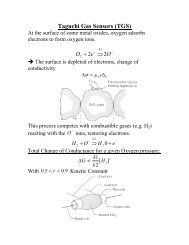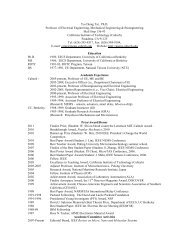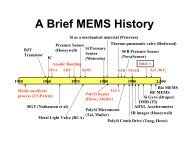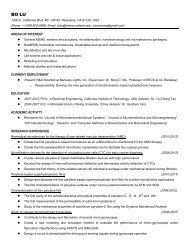02-a Wet etching - Caltech Micromachining Laboratory
02-a Wet etching - Caltech Micromachining Laboratory
02-a Wet etching - Caltech Micromachining Laboratory
Create successful ePaper yourself
Turn your PDF publications into a flip-book with our unique Google optimized e-Paper software.
~,<br />
Vol. 123, No. 1% ,'" .'. -CHEMICAL ETCHING OF SILICON' " " .,1t"'1--2~}-<br />
'.. .,.:'j~,:,;,,~.:::~..<br />
~ 0 lower portion of each plot, the' constant etch-rate traduction -of a catalyat, and the BQ etch mil<br />
II.<br />
eo<br />
contours of both systems run identical course. over<br />
a considerable range of compositions. In ~ upper<br />
to be quite useful in device work. .<br />
--1-n summary, the behavior of the water d<br />
~d<br />
tnd<br />
portion of each plot, however, the contours diverge<br />
immediately upon the addition of diluent. The note-<br />
Acetic acla-ailu{ed etches based on HF arid<br />
_qualitatively verv similar J~~is governed<br />
, u<br />
ate<br />
worthy feature here is that the contours for the acetic<br />
acid system run parallel with lines of constant nitric<br />
considerations. The differences are DrimJ .<br />
ta Ive an -leranc<br />
) a acid concentration and the plot in general bears a f~r acetic acid than for water.~his does not<br />
nd<br />
striking resemblance to the high concentration acid<br />
system shown in Fig. 5rThe eQuivalent <strong>etching</strong> systems<br />
the acetic acid diluted system is less critical<br />
water diluted system, with respect to composi<br />
eo HF HNO3 + diluent are seen to show- a much-merely that a greater amount of diluent may<br />
te ~ter tolerance tor acetic acid than tor water as the ~ before the system becomes critical with r<br />
the diluent. diluent or composition. Except in the high H<br />
ha<br />
?~~~n this section it was shown that in the<br />
high HF region the etch rates are affected by the oxiboth<br />
systems are initially indifferent to the ad<br />
diluent, and the <strong>etching</strong> behavior is unaltered<br />
ra:<br />
~<br />
dizing ability of the nitric acid and the reaction is<br />
critical with respect to the coupling of the generated<br />
com}:osition is reached where the direction of<br />
tours begins to change. Then feedback m<br />
a c<br />
catalyst. Th tolerance s stem for ace ic acid<br />
-is thus i!:! ~~c~rd ~jt!! the known elUlanc= oxidizing<br />
come into play and the behavior of the sol<br />
comes erratic. It is significant that the etc'<br />
e power of nitrIC acid in acetic aclQ over tnatof nitric acteristics reflect the critical depen.denc:e of.<br />
xtr acI In e a I Ion oes rate on the local catalyst concentration m<br />
.r no re uce the oxidizing power of the nitric acid until so that a favorable geometry is obtained at the<br />
no a fairly large amount of the diluent has been added. of erratic or unpredictable behavior of the<br />
vol Therefore, the rate contours remain parallel with lines Any attempt to make the etchant noncritical,<br />
.1 s of constant nitric acid over a considerable range of an increase in temperature or the excessive<br />
.added diluent. of catalyst, will simultaneously produce. a<br />
q The same explanation is valid in the high HNO3 the geometry ot the specimen to that ch<br />
d region. The sudden dependence of the etch rates on of a diffusion-limited mechanism.<br />
ly<br />
; S<br />
the amount of added diluent has been associated with<br />
a transition from an oxidation-independent mechanism<br />
In the high HF region, the solution is criti<br />
respect to the addition of water, because th<br />
co to an oxidation-dependent mechanism. The effe r..it f amount of diluent is already contained in<br />
s. the acetic acid is primarily to defer the onset of centrated stock HF. The use of acetic aci<br />
oxidation-dependent mechanism until<br />
amount of this diluent has been added.<br />
a very e region may serve some purpose in making<br />
less critical, and some useful sizing etches<br />
The striking similarity of the water diluted <strong>etching</strong><br />
system and the acetic acid diluted system, coupled with<br />
found here. It is surprising that the commo<br />
containing acetic acid, such as CP4, were n<br />
~ the nature consistency of the diluent, of the provides etch rates an additional irrespective argument of the ulated addition in of this acetic region, acid but seems in the to region serve wn<br />
in favor of the diffusion-governed mechanism pre- purpose. (The amount of acetic acid in CP4 .<br />
viously proposed.,~he fa,ct tha~. t!!e et£hrates-are<br />
affected b the enhanc ctivity of the nitr"<br />
not less than critical.)<br />
It is often said that acetic acid moderates<br />
in acet cid can only be ex a on basis th action and slows the rate. This is not true in<br />
!!!~remffusion limited-:oor- r-e-a:-ctlvit): 20~ nit~ic acid region, and in. ~h.e high hydr°fi.u<br />
The acetic acid diluent etch composition plane may<br />
also be subdivided into general areas having different<br />
regIon. How~ver,.m the vIclmty of the maxI<br />
rate, the acetIc acId d°.es have the alleged effec<br />
geometric <strong>etching</strong> characteristics (see Fig. 9). The It. seems on the basIs of the small amo~nt<br />
principal difference between the two systems is that mat~on we h~ve present~d th~t ~y <strong>etching</strong><br />
()<br />
the areas in the acetic acid system are more extensive. attainable with an acetIc acId diluted etch<br />
" .duplicated with a water diluted etch. The<br />
In FIg. 9, we have IndIcated several commonly used diluent is thus a matter of individual preferenc<br />
~ etches. The BJ etch and the CP4 etch are seen to be<br />
~ located in area C, and they should have similar properties.<br />
On the basis of our interpretation of the reaction Applications .,<br />
ck (~~~~~~~niS~ in this area, we would venture that ~he A process specification for the fabrication of a semi- -' :<br />
..romlne .the CP~ .formula seryes no u~eful function conductor device usually includes one or more ~>-~: '.<br />
e <strong>etching</strong> of Sllicon to obtain a ~pecIfic geometry. ical <strong>etching</strong> steps. The <strong>etching</strong> operation is employed :';::r~-:-<br />
The sa~e comment may be made WIth respect to the for the attainment of certain objectives such as the' .:~;~<br />
~m ~he Purdue etches. There may be factl?rs, reduction of reverse current, machining to size, or. the .:.. .;;'"<br />
""1h~,which we ~ave not ev.a1uated, such as.resulting removal of unwanted material. The diversity of cirelectrIcal<br />
propertIes of devIces etched WIth these cumstances under which the <strong>etching</strong> is performed,<br />
,<br />
{ I ~!~:!o~~~ :~~~. ~g_~t__~h~~_~nee~. for the. addit!,:,.e' coupled with the infinite variability of the <strong>etching</strong><br />
-<br />
~~ ""~~1JOlnt of .v~ew. ?OWev~r. the use of an a~~ formulas has created a fertile field for the sorcerer<br />
~ \ c tive in sur}, ,.nmpn~itinn~ ii po;ntl°i~ ~ and alch~mist to practice their arts. It was inevitable<br />
The 111 etch is interesting because it lies in a region that some excellent <strong>etching</strong> procedures should have<br />
'.<br />
where the resultant surfaces are specular, but where<br />
the corners tend to peak. It should produce better<br />
been discovered in the course of time. However, these<br />
procedures were applicable only to the attainment of<br />
geometry retention than the BJ etch and it should be limited objectives with specific devices. Every situamore<br />
reliable in the absence of addea catalyst than its tion became a separate problem which had to be coped<br />
-E neighbor, the BQ etch. The latter is very critical, with with on a hit-or-miss basis, without the guidance of<br />
respect to slight changes in composition, and with re- scientific principles, In such a state of affairs, a method<br />
spect to the silicon surface. Infinitesimal composition for the selection of the optimum etch to accomplish a<br />
changes such as the addition of one drop of acetic acid given objective appeared to be extremely valuable.<br />
to 20 cm3 of etchant, or the use of 48.5% HF instead A key to the selection of an etch is an understanding<br />
of 48.9% HF to prepare the solution, have been ob- of the <strong>etching</strong> characteristics of a solution as a function<br />
-.served to cause the second etch rate (i.e., <strong>etching</strong> of a of the composition. The physical factors that influence<br />
-work-damage-iree surface) to vanish. It has been the <strong>etching</strong> behavior have aready been discussed. It<br />
observed that the etch rate in the BQ composition may may now be desirable to recapitulate some of the<br />
have practically any value between zero and the di.fIu- concepts developed above and show how they can be.<br />
K sion-limited value for that composition. However, these applied to the formulation of an <strong>etching</strong> solutioD<br />
disadvantages may possibly be overcome by the m- having certain specific properties.<br />
~<br />
~









